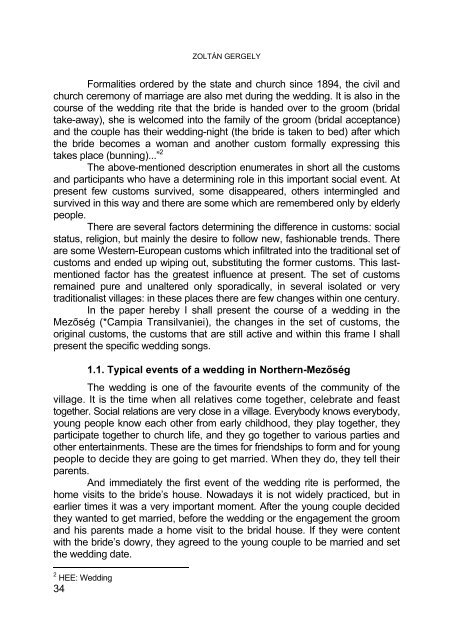musica - Studia
musica - Studia
musica - Studia
Create successful ePaper yourself
Turn your PDF publications into a flip-book with our unique Google optimized e-Paper software.
ZOLTÁN GERGELY<br />
Formalities ordered by the state and church since 1894, the civil and<br />
church ceremony of marriage are also met during the wedding. It is also in the<br />
course of the wedding rite that the bride is handed over to the groom (bridal<br />
take-away), she is welcomed into the family of the groom (bridal acceptance)<br />
and the couple has their wedding-night (the bride is taken to bed) after which<br />
the bride becomes a woman and another custom formally expressing this<br />
takes place (bunning)...” 2<br />
The above-mentioned description enumerates in short all the customs<br />
and participants who have a determining role in this important social event. At<br />
present few customs survived, some disappeared, others intermingled and<br />
survived in this way and there are some which are remembered only by elderly<br />
people.<br />
There are several factors determining the difference in customs: social<br />
status, religion, but mainly the desire to follow new, fashionable trends. There<br />
are some Western-European customs which infiltrated into the traditional set of<br />
customs and ended up wiping out, substituting the former customs. This lastmentioned<br />
factor has the greatest influence at present. The set of customs<br />
remained pure and unaltered only sporadically, in several isolated or very<br />
traditionalist villages: in these places there are few changes within one century.<br />
In the paper hereby I shall present the course of a wedding in the<br />
Mezőség (*Campia Transilvaniei), the changes in the set of customs, the<br />
original customs, the customs that are still active and within this frame I shall<br />
present the specific wedding songs.<br />
2 HEE: Wedding<br />
34<br />
1.1. Typical events of a wedding in Northern-Mezőség<br />
The wedding is one of the favourite events of the community of the<br />
village. It is the time when all relatives come together, celebrate and feast<br />
together. Social relations are very close in a village. Everybody knows everybody,<br />
young people know each other from early childhood, they play together, they<br />
participate together to church life, and they go together to various parties and<br />
other entertainments. These are the times for friendships to form and for young<br />
people to decide they are going to get married. When they do, they tell their<br />
parents.<br />
And immediately the first event of the wedding rite is performed, the<br />
home visits to the bride’s house. Nowadays it is not widely practiced, but in<br />
earlier times it was a very important moment. After the young couple decided<br />
they wanted to get married, before the wedding or the engagement the groom<br />
and his parents made a home visit to the bridal house. If they were content<br />
with the bride’s dowry, they agreed to the young couple to be married and set<br />
the wedding date.

















